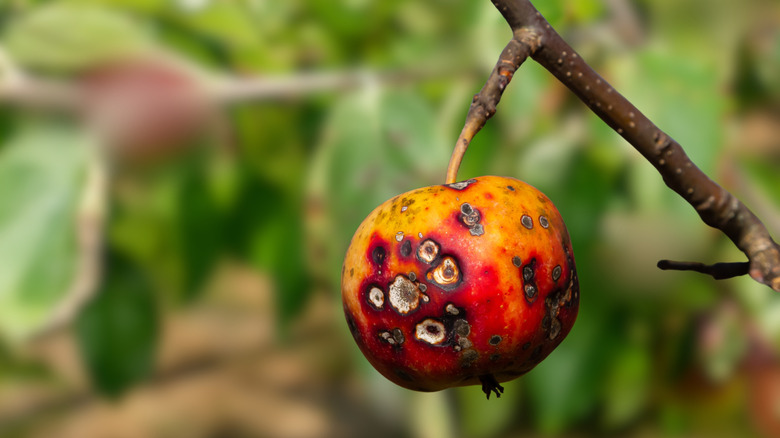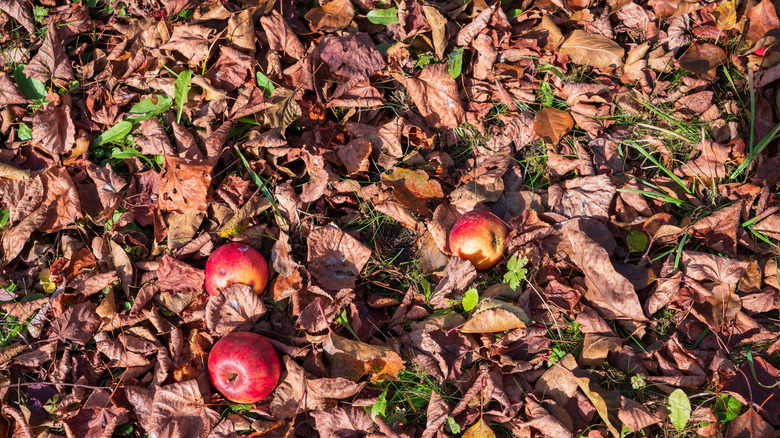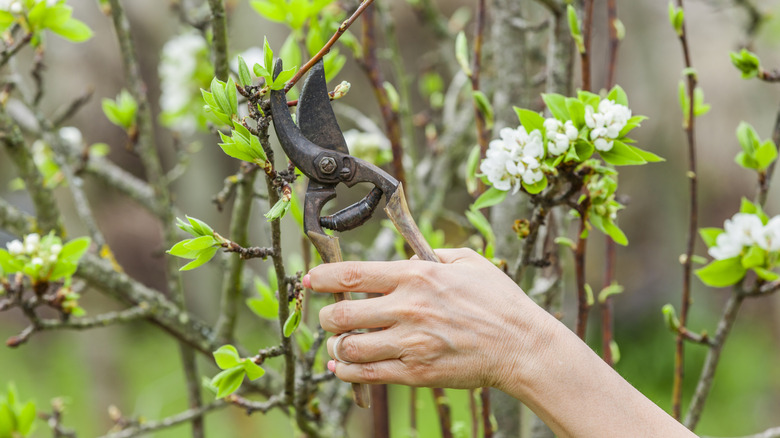The Spotty Disease To Watch Out For That Can Destroy The Harvest Of Your Apple Tree
It might be easy to grow and care for an apple tree, but keeping it safe? Well, that is where the problems begin. There is no shortage of pests and diseases that affect it, and any one of them could destroy the harvest of your tree. Take, for example, apple scab. Among apple diseases, scab ranks near the top, and sadly, most of the common apples and crabapples that we grow are susceptible to it. Caused by a fungus, apple scab affects both leaves and the fruit. It is especially bad in areas with cool and moist springs. The disease starts quietly, showing up as olive-green, velvety spots on blossoms, leaves, or young fruit.
However, as time goes by, those spots darken, merge, and harden into corky, cracked patches. Sometimes, even the twigs and buds get affected. And the worst part is, the damage isn't just cosmetic — it can seriously affect fruit quality and yield. Without proper control, apple scab can slash yields by 20% to 70%, and that's just the beginning. If the conditions are right, secondary infections can pop up several times during the growing season, each time hitting the tree harder than before. You'll need a combination of proper clean-up, watering practices, and fungicides to deal with the issue.
Understanding what causes apple scab
If you want to stand a chance against apple scab, understanding its life cycle and the conditions that fuel its spread are where you should start. Venturia inaequalis, the fungus that causes apple scab, overwinters in the leaf litter beneath infected trees, quietly waiting for spring to return. Then, just as the buds begin to open, the fungus makes its move. All it needs is a bit of rain, and its spores shoot up into the air, setting the stage for the next wave of infections. After landing on the plant, the spores germinate, and it only takes about 9 to 17 days for the spots and lesions to appear.
Once the lesions form, they start producing secondary spores. These are easily carried by wind or rain to nearby leaves and fruit, spreading the disease again and again throughout the season. Weather plays a huge role, with warm and wet spells giving the fungus the perfect opportunity to spread and thrive. Apple scab is just one of the downsides to growing your own apple tree that you should consider before you go all in.
Controlling and treating apple scab
Effective control of apple scab relies on combining cultural practices with timely fungicide treatments. The first step is to get rid of those fallen leaves. It essentially wipes out the places where they could survive and mature. You can also treat the leaf litter under the trees with urea, around or in November, after about 95% of the leaves have dropped. This simple thing can cut the number of trapped spores in the litter by up to 50%. Timely pruning of the trees can also help. The best time to prune your apple tree is in early spring.
Not only will it help your tree produce more fruit, but it will also allow more sunlight and air to pass through the canopy, reducing humidity and making conditions less favorable for the fungus to infect and spread. Also, water early in the day and avoid overhead watering to help reduce moisture on the foliage. If you can, try to use drip irrigation or sprinklers that don't spray the foliage. If you want to control the disease with fungicides, they can definitely help, but once again, they are preventive, not curative.
Once leaf spots show up, it's too late to apply fungicides. Ideally, you need to start your fungicide routine early in the season — right at the green tip stage. You will need to do this every 7 to 10 days — 7 days during wet weather, and 10 days if conditions stay dry. And, if you do not want to deal with this headache at all, turn to resistant varieties of apples like Enterprise, Macfree, Freedom, and Prima.


